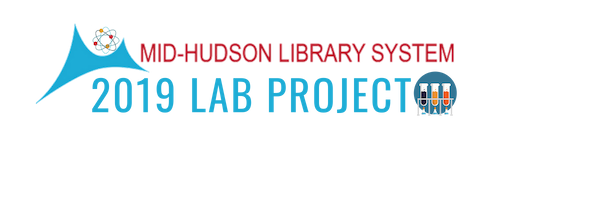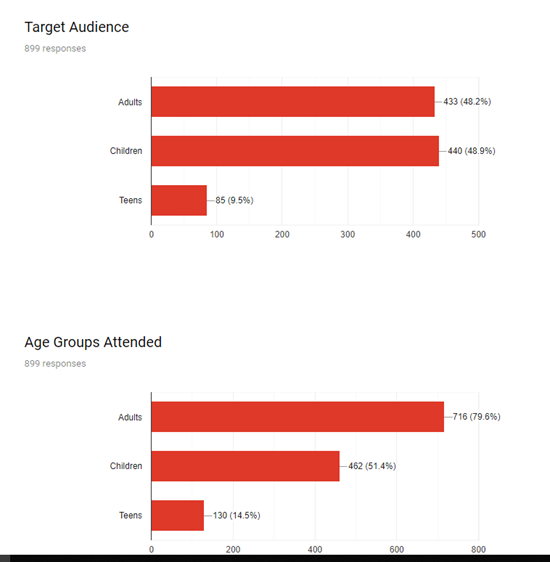Lab Project 2019 – Increasing Program Attendance
Overview
The MHLS 2019 Lab Project identified and tested key strategies and best practices to increase adult program attendance.
Participating Libraries
- Fran Harrison – Grinnell Public Library District
- AnnaLee Dragon – Kinderhook Memorial Library
- Michele Capozzella – Mahopac Public Library
- Maureen Garcia – Mountain Top Library
- Chrissy Lawlor – Olive Free Library Association
- Dawn Jardine – Red Hook Public Library
- Brooke Dittmar – Town of Esopus Library
- Brian James – Town of Esopus Library
Project Goal
To design and evaluate library services in a way that creates opportunities and addresses needs in our community so that more people will benefit from the programs offered by their library.
Objective
5% increase in adult program attendance.
Key Strategies Adopted
- Create a Programming Mission Statement
- Create Talking Points for staff
- Reach out to Non-user Groups to Do Programs and Solicit Feedback / Input
Project Timeline
- Friday, May 17 at 10 am – Online Meeting
- Monday, June 17 from 2 pm to 4 pm – In-person Meeting at MHLS Auditorium
- Thursday, August 15 at 10 am – Online Meeting
- Friday, September 6 at 10 am – Panel Presentation of Findings at the Directors Association Meeting at MHLS Auditorium
- Thursday, December 12 at 10 am – Online Meeting
Metrics
Adult program attendance for a specific month of the current year was compared to adult program attendance for the same month in the previous year.
Other Strategies and Best Practices Identified
This list includes strategies that were developed by the 2019 Lab Project Cohort and as well as strategies developed and shared with the group by Janie Hermann, Adult Programming Manager at the Princeton Public Library.
- Plan programs in advance – Create and schedule programs 3 to 6 months in advance for adequate time to organize and publicize events.
- Programmers’ retreat – Make time for program staff to get together and plan far enough in advance. Set goals for attendance.
- Forecasting and trend-spotting – Watch the publishing world- Edelweiss or NetGalley – for upcoming hot topics and build programs around those topics. Watch for local events that your programming can tie into. Look at Chase’s Calendar of Events.
- Organize programs around a them to create a series – Choose insightful themes (Summer of ’69) to build a programming series (Woodstock, moon landing, Stonewall).
- Set goals – A goal for how many programs to do outside the library, with partners, or a goal to increase attendance, or to reach a specific group can increase the quality of your library’s programming.
- Create talking point bookmarks – A bookmark with information about about upcoming events can create and easy way for front-line staff to start a conversation (or up-sell) about programs happening at the library with a patron, and put the info about the program in the patron’s hands.
- Ads on Facebook, radio, public access TV – Budget funds to use for advertising.
- Twitter – A well-built Twitter following can be great for getting the word out about an event quickly.
- Weekly email newsletter featuring programs that week – People don’t plan their lives quarterly and need more timely information about what’s coming up at the library. Princeton’s weekly newsletter has a 40% click-through rate, and 20,000 subscribers (population served: 30,000), and half of attendees at events say they heard about the event from the newsletter.
- Segmented email newsletters – For patrons to subscribe to communications about specific types of events they’re interested in.
- Facebook – Facebook is good for creating events, but the algorithm can be tough to get posts about events to rise in users’ news feeds.
- Tell people about upcoming events at programs – Talk up upcoming events to the audience right when introducing the program they came for.
- Publish newsletter to issuu – Distribute your newsletter content on this platform to reach more people. issuu is also a good resource for finding ideas for programs from other libraries.
- Email newsletter signups – People want to hear about the events at your library! Educate staff about your newsletter signup form on your website, send around a clipboard with a signup sheet before each event.
- Talking points for board – Recruit board members to promote programs to their contacts in the community.
- Community program survey – Ask your community what kind of programs they want. Use Pleasant Valley’s survey as a model to get started.
- Suggestion form – Provide a suggestion box to solicit feedback about programs.
- Project Outcome Surveys – These surveys can measure the true impact of your programs, and assess whether they’re meeting your library’s goals. The Education and Lifelong Learning survey is good for many adult programs.
- Send reminders to registrants – Automate reminders for people registered for an event using calendar software, or call them for a personal touch to let them know they signed up for an event.
- Remove program registration – Registration could be a barrier to people coming.
- Collaborate on programs with outside organizations and at outside locations – Programs done in partnership with other organizations increase the pool of people who will hear about that program and your library by expanding your audience to include the other organization’s as well in promoting your partnership event. Partnerships can also bring in unique content for your programs that your library staff does not have expertise in. Programs that happen outside of your library building give you a chance to meet people who would not normally come to your library
- Visit and speak at other organization’s meetings – Take five minutes at a local organization’s meeting (Rotary Club, Parent Teacher Organization) to let them know what’s coming up at the library and hear about ways you can support their organization or the individual members of that organization.
- Keep your website up-to-date – This is where most people will begin searching for programs at your library. Highlight events on your website.
- Track your attendance and programs – A google from, which populates a spreadsheet can be used to easily track and later evaluate what kind of programs work, what times and dates work, and more. Janie Hermann at the Princeton Library found that Sunday afternoons, Mondays and Tuesday were all viable and effective times to provide library programs, contrary to popular sentiment.
- Below are some metrics to consider tracking:
- Type of program
- Category
- Name of program
- Date
- Day of Week
- Time of Day
- Program category
- Attendance
- Target Audience
- Age groups attended
- Did the program meet expectations?
- If applicable, explain why the program exceeded or failed expectations.How many staff worked this event?
- Staff responsible for organizing event
- Did this program have community partners?
- List of relevant community partners – aka promotional partners (reach out and do things at other places besides the library)
- Where did this program take place?
- Grant category
- Was this a volunteer run program?
- Possible outputs from some of the form questions above:
- Below are some metrics to consider tracking:




